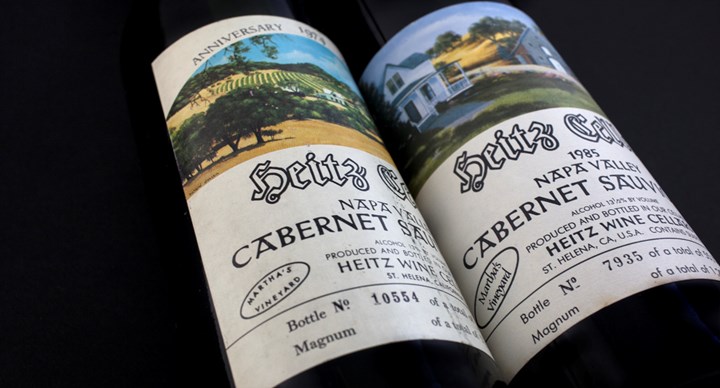
Which site would you like to visit?
By clicking the retail or wholesale site button and/or using rarewineco.com you are choosing to accept our use of cookies to provide you the best possible web experience.

If you were an oenophile in the 1970s, you may still have that hypnotic bouquet of eucalyptus imprinted in your memory.
The smell, of course, belonged to Heitz’s Martha’s Vineyard Cabernet, a wine whose rich, opulent palate would have made it legendary, even had its nose not been so distinctive.
First made by Joe Heitz in 1966, Martha’s Vineyard was arguably the most coveted Cabernet at the birth of modern California wine. And after the great 1966, magnificent vintages in 1968, 1970, 1974 and 1985 secured Martha’s position as the finest of its generation.
But the dawn of the 1990’s Cult Cab movement obscured the previous generation of Cabernets, and Martha’s was the most puzzling casualty.
Its style was considered very opulent in its day, and even by today’s more ambitious standards it remains exotically compelling. Now, nearly a half century after it became the first great single-vineyard California Cabernet, it still mesmerizes with its astonishing bouquet and its warm, velvety texture.
In the summer of 1974, David Heitz completed his enology degree and returned to his family’s winery on the eastern edge of Napa Valley. Over the preceding decade, David’s father Joe had become a towering figure in Napa wine circles, nearly as famous for his strong opinions as for his pioneering wines. But that summer, Joe hurt his back and was laid up in bed.
Newly armed with his enology degree, but guided by his father every step of the way, David jumped into the breach, bringing in the 1974 harvest and vinifying, among the other Heitz wines, the 1974 Martha’s Vineyard Cabernet. Little did he (or anyone else) know that the wine would become among the most famous in California history.
So pleased was Joe with the wine that, as David jokes, “my father … decided that he would have no problems leaving the duties at crush to me and heading out to the beach each year at harvest time.”
So, while Martha’s Vineyard Cabernet will always be associated with Joe Heitz, few people know that his son David has been its maker since 1974, turning out countless great vintages, following the principles laid down by his father.
Today, 45 years after the first Martha’s, nothing has changed in how it is made.
Of course, the wine would never have existed without Martha’s Vineyard, which lies on a gentle slope on the western side of the valley in the foothills of the Mayacamas Mountains just south of Oakville. It is the quintessential western Napa Valley terroir; the soils a mix of valley floor alluvial silts, gravels and eroded rock from the Mayacamas range, with perfect exposure and drainage.
The vineyard is surrounded by giant eucalyptus trees, often credited as the source for Martha’s distinctive minty aroma and flavor. And the plant material is a unique proprietary clone that produces tiny, thick skinned berries of great concentration and deep color.
Owned by Tom and Martha May, Martha’s Vineyard has been made exclusively by Heitz since 1966; Joe had begun purchasing the fruit the previous year, blending it with other sources for his Napa Valley bottling.
But Tom May asked Joe if he could have a barrel of the wine bottled on its own as part payment for the grapes. So impressed was Joe by the wine’s completeness and character, he quickly agreed to bottle the total production separately the following year.
The way in which Martha’s Vineyard has been made over the past 45 years came straight from Joe Heitz, one of the great personalities of Napa’s golden decade of the 1960s, and among its most gifted winemakers.
Prior to starting his own winery in 1961, he was the legendary André Tchelistcheff’s right-hand man at Beaulieu Vineyards for eight years. Later he became the very first to issue a single-vineyard bottling of Napa Valley wine with the release of the 1966 Martha’s Vineyard Cabernet in 1970.
Today, David Heitz uses the same methods his father did in 1966 to make Martha’s Vineyard: fermentation is in stainless steel tanks followed by a full year in very large neutral American oak casks before another three years in French oak barriques prior to bottling.
One surprising aspect to the Heitz approach is that their Cabernets do not go through malolactic fermentation. As David Heitz told John Gilman, “this was how my father made his Cabernets, and given how well they had turned out over the years, I could see no good reason for changing this.”
This unusual method surely is a factor in Martha’s famed ability to age for decades.
Heitz Wine Cellars Martha’s Vineyard Cabernet is not only one of California’s greatest wines, it is also one of the last living examples of traditional Napa Valley winemaking, unchanged now for nearly half a century.
| Year | Description | Size | Notes | Avail/ Limit |
Price | |
|---|---|---|---|---|---|---|
| Please Call (415) 319-9000 for Availability | ||||||
New discoveries, rare bottles of extraordinary provenance, limited time offers delivered to your inbox weekly. Be the first to know.
Please Wait
Adding to Cart.
...Loading...


By clicking the retail or wholesale site button and/or using rarewineco.com you are choosing to accept our use of cookies to provide you the best possible web experience.

